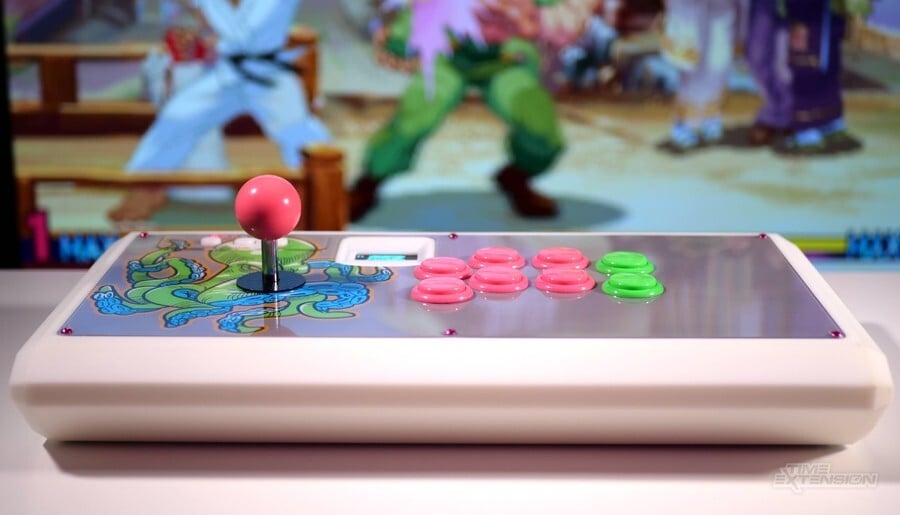
If you're a serious fighting game fan, you'll almost certainly own an arcade stick of some description. Titles like Street Fighter, Samurai Shodown and King of Fighters were always designed to be played in the arcades first and foremost, and they rely on precise, low-latency digital input – especially when played at a competitive level.
One-on-one fighting fans have always been relatively well-serviced when it comes to controllers, but the biggest issue is the need to upgrade your stick for every new platform you use. Sure, there are examples which will work across generations (Xbox One > Series S and PS4 > PS5, for example), but there's never truly been a great arcade stick which can function across multiple formats – until now, anyway.
Turkish company TR Fight Stick has launched a crowdfunding campaign for what it hopes will become the gold standard for fighting game aficionados: the Octopus Arcade Stick.
The headline news with this particular stick is that it won't be limited to a single platform; using a standard LAN connection, it will be able to link with a wide range of systems, including Switch, PS5, MiSTer, PC, Steam Deck, Dreamcast, Saturn, Analogue Pocket (via its dock, obviously), Xbox 360 and – if its stretch goals are met – OG Xbox and Neo Geo. Since the crowdfunding campaign went live, TR Fight Stick has revealed that it has partnered with Brook Gaming – a company which produces adapters that allow controllers to be used across different systems – and that means Octopus is going to add even more console support to its arsenal in the future. In short, it's promising to be the one-stop solution for all serious fighting game lovers, but what's it like to actually use?
We were fortunate enough to be sent a prototype of the Octopus, and we've been putting it through its paces over the past week or so. The unit we were sent isn't final – it comes in a 3D-printed shell (the final version will boast a high-quality injection-moulded case), and it currently only supports Dreamcast. Even so, it's clear that the Octopus is shaping up to be a pretty exciting proposition.
First up, the size of the stick is perfect, especially when compared directly to the official arcade stick Sega released for the Dreamcast all those years ago. It's roomier and easier to rest on your knees, and it comes with an additional two face buttons for more control options. High-grade Sanwa parts are used throughout, which is another indication of quality.
The other point of note is that the Octopus has a built-in LCD display which aims to replicate the functionality of the Dreamcast VMU. An SD card inside means you have the equivalent of 10 different VMUs inside the Octopus, giving you ample storage space for your save data. Switching between them requires a rather awkward combination of buttons (hold 4K + 4P + Start, and then press left / right to switch cards), but at least it means you won't accidentally switch VMUs mid-game. The LCD is backlit and has various other symbols and indicators included, which we'll come to shortly.
Because this is a serious tournament-level stick, there's even a switch on the back which allows you to disable the 'Start' button (also found on the back). This is to prevent any accidental pauses during competitive gameplay – something that can get you disqualified in some tournaments.
Three other function buttons are found in the top-left corner of the stick. This first toggles SOCD on and off. This feature isn't active as yet, but once it is, it will allow support of Hit Box's 'Simultaneous Opposing Cardinal Directions' system, which will be of particular interest to earnest competitive fighting game players (it's a bit too complex for us). The middle button allows you to toggle the stick between 'digital' and 'analogue' input, while the final button controls Turbo functionality. These features have corresponding indicators, which are displayed on the LCD screen.
The Octopus certainly packs in a lot of functionality, but that would stand for very little if it didn't succeed in its primary goal: being a solid fighting stick. The good news is that, even in its prototype form, this is one seriously good controller. We wouldn't claim to be fighting game experts here at Time Extension – our competitive days ended during the Saturn and Dreamcast era, if we're honest – but after a few moments in the company of this stick, we were pulling off special moves with ease in games like Capcom vs SNK 2, Marvel vs Capcom 2 and Garou: Mark of the Wolves.
When placed side-by-side with the official Dreamcast arcade stick, the Octopus is the clear winner – so, even if you're only after the ultimate control solution for your Dreamcast, the Octopus is already a solid purchase. However, the fact that it will be compatible with other platforms sweetens the deal considerably.
The catch here is that we're currently unable to test just how well the Octopus will perform when it's paired with other consoles – and that might be a major point of consideration, as, with its VMU functionality, it has clearly been designed with the Dreamcast in mind first and foremost.

The next sticking point is the price. TR Fight Stick aims to sell the Octopus for $400 USD, although it currently has 'early bird' options on its IndieGoGo page which allows a limited number of customers to save considerably on that cost. That's a lot of green for any gaming controller, no matter how many platforms it may eventually work with – but you could argue that, given you're getting multi-platform support in single purchase, many will see it as a steal.
For now, we'd say we're definitely interested in seeing how the Octopus evolves over time – it certainly has the foundations in place to become one of the best fighting sticks money can buy.
